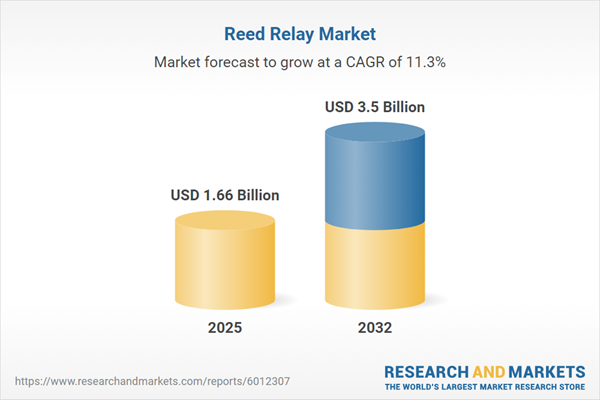Speak directly to the analyst to clarify any post sales queries you may have.
Reed relays have become integral to modern electrical switching, supporting critical industries that require fast, reliable, and compact solutions for precision control challenges. As electrical systems continue to evolve, senior decision-makers face mounting pressure to future-proof operations through informed technology adoption and supply chain resilience.
Market Snapshot: Reed Relay Market Growth and Opportunity
The Reed Relay Market grew from USD 1.49 billion in 2024 to USD 1.66 billion in 2025, and it is anticipated to maintain strong momentum with a CAGR of 11.25%, reaching USD 3.50 billion by 2032. Multiple sectors are intensifying investment in precision switching technology as new automation demands, energy efficiency targets, and miniaturization priorities accelerate change. This sustained market expansion positions reed relays as a prime focus for procurement and innovation leaders advancing switching reliability and operational agility.
Scope & Segmentation
This report provides exhaustive coverage and actionable analysis of the evolving reed relay landscape. The market segmentation highlights both the breadth and the technical depth of solutions, supporting strategic planning for expanding end-user requirements.
- Actuation Types: Electromagnetic, Latching
- Pole Throws: 4PDT, DPDT, SPDT, SPST
- Mounting Methods: Chassis Mount, DIN Rail Mount, Panel Mount, PCB Mount
- Applications: Automotive (Electric Vehicle, Internal Combustion Engine), Consumer Electronics (Home Appliance, Mobile), Industrial (Energy, Manufacturing), Medical (Diagnostic, Therapeutic), Telecom (Wired, Wireless)
- Regions Covered: Americas (United States, Canada, Mexico, Brazil, Argentina, Chile, Colombia, Peru), Europe, Middle East & Africa (United Kingdom, Germany, France, Russia, Italy, Spain, Netherlands, Sweden, Poland, Switzerland, United Arab Emirates, Saudi Arabia, Qatar, Turkey, Israel, South Africa, Nigeria, Egypt, Kenya), Asia-Pacific (China, India, Japan, Australia, South Korea, Indonesia, Thailand, Malaysia, Singapore, Taiwan)
- Leading Companies Profiled: TE Connectivity Ltd., Standex International Corporation, Coto Technology Inc., Littelfuse Inc., Pickering Electronics Ltd., CTS Corporation, Panasonic Corporation, Omron Corporation, Vishay Intertechnology Inc., Murata Manufacturing Co. Ltd.
Key Takeaways for Senior Decision-Makers
- Reed relay technology supports miniaturization and circuit densification, aligning deployments with next-generation electronics trends.
- Enhanced material innovations and advanced contact designs are extending product life and increasing operational stability in challenging environments.
- Smart sensor integration and IoT connectivity foster predictive maintenance capabilities, enabling data-driven asset management and reduced downtime.
- Regulatory requirements for lead-free and recyclable components are reshaping assembly strategies and accelerating adoption of sustainable materials.
- Strategic partnerships—including collaborations with research institutions and exclusive distributor agreements—allow for competitive advantage through targeted innovation and market access.
- Regional diversification offers resilience; Asia-Pacific’s manufacturing strengths, EMEA’s focus on compliance, and the Americas’ reshoring efforts each require tailored approaches.
Tariff Impact: Navigating U.S. Policy Changes
The revised United States tariffs on critical electronic materials in 2025 are prompting company leaders to reconsider sourcing, production, and cost management. Increased duties on input components have led many manufacturers to localize key manufacturing steps or finalize supply arrangements abroad to contain cost volatility. These environmental shifts directly impact procurement strategy, lead times, and product design choices—making agile response planning and robust supplier relationships essential to sustaining supply chain performance.
Methodology & Data Sources
This report leverages primary research from expert interviews supplemented with secondary data, technical filings, and trade association insights. Triangulation from multiple data streams ensures reliability, with interim analyses validated by external consultants to refine findings and frameworks for maximum relevance.
Why This Report Matters for the Reed Relay Market
- Senior executives gain deep visibility into global reed relay trends, regulations, and supply dynamics to guide procurement and R&D investments.
- Competitive benchmarking and segmentation insights enable tailored product and market entry strategies to capture high-growth opportunities.
- In-depth coverage of technical and regional trends ensures readiness to respond to evolving end-user demands and regulatory shifts.
Conclusion
The reed relay sector is undergoing rapid transformation, shaped by technological progress, shifting regulatory priorities, and global market realignment. Decision-makers are equipped with rich market intelligence to shape strategies that ensure resilience, competitiveness, and responsive innovation for the years ahead.
Additional Product Information:
- Purchase of this report includes 1 year online access with quarterly updates.
- This report can be updated on request. Please contact our Customer Experience team using the Ask a Question widget on our website.
Table of Contents
3. Executive Summary
4. Market Overview
7. Cumulative Impact of Artificial Intelligence 2025
Companies Mentioned
The companies profiled in this Reed Relay market report include:- TE Connectivity Ltd.
- Standex International Corporation
- Coto Technology Inc.
- Littelfuse, Inc.
- Pickering Electronics Ltd.
- CTS Corporation
- Panasonic Corporation
- Omron Corporation
- Vishay Intertechnology, Inc.
- Murata Manufacturing Co., Ltd.
Table Information
| Report Attribute | Details |
|---|---|
| No. of Pages | 187 |
| Published | October 2025 |
| Forecast Period | 2025 - 2032 |
| Estimated Market Value ( USD | $ 1.66 Billion |
| Forecasted Market Value ( USD | $ 3.5 Billion |
| Compound Annual Growth Rate | 11.2% |
| Regions Covered | Global |
| No. of Companies Mentioned | 11 |









